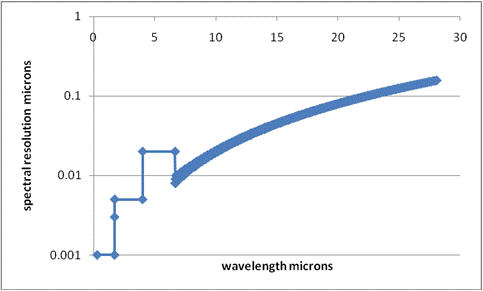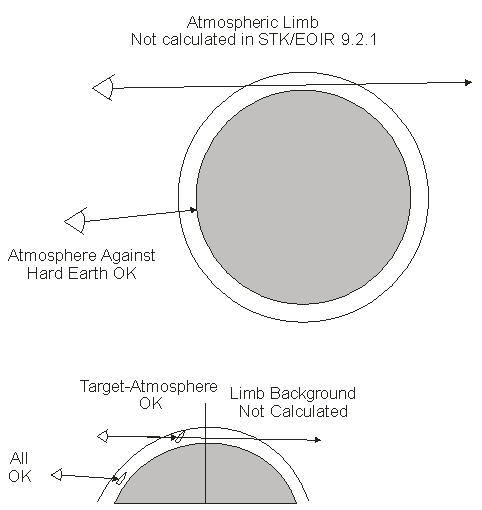EOIR Atmosphere Model
To set the EOIR atmosphere model, click from the EOIR Configuration window and select the Atmosphere tab. You can then select from the Modes pane and the Parameters pane.
Atmosphere modeling
Select one of the following atmosphere modes for your EOIR scene:
- Atmosphere Off - no atmosphere model nor atmosphere parameter setting
- Simple Atmosphere
- MODTRAN-derived Lookup Table
Simple Atmosphere
This atmosphere model calculates the following atmospheric properties at the wavelengths corresponding to the Spectral Band Edges and at a spectral resolution specified by the Number of Intervals set on the sensor's EOIR Spectral Properties page:
| Property | Description |
|---|---|
| Transmission | This is what gets through the atmosphere after light is differentially absorbed and scattered out of the light ray. |
| Scatter In | This is the light scattered into the ray by Rayleigh and Mie aerosol scattering. Rayleigh scattering is what makes the sky blue. Mie aerosol scatter is what adds the white haze. |
| Path Radiance | This is the infrared emission of the atmosphere into the ray. |
The amount of atmosphere traversed by a ray affects the calculations described above. EOIR calculates this value for all atmospheric geometries of sensor and target location, except for space to atmosphere to space.
EOIR does not calculate the atmospheric limb.
All of the preceding calculations use the U.S. Standard 1976 atmospheric layer model to specify data such as temperature and pressure by altitude layer. This is similar to calculating an annual average of the atmosphere in the central United States.
The Simple Atmosphere model only uses variations of atmospheric properties with altitude. It does not calculate the horizontal variations — which constitute weather — nor clouds.
The atmospheric spectral resolution used in scene generation is the lesser of EOIR's maximum atmospheric spectral resolution, shown below, or the one resulting from the selected EOIR Spectral Properties "Number of Intervals" within the selected spectral band.

MODTRAN-derived Lookup Table
MODTRAN is a community standard, and the MODTRAN-derived Lookup Table model is one of the highest-fidelity atmospheric models available in EOIR. For a description of this model, go to the Atmospheric Loss section of the Laser Environment Properties topic page.
Atmosphere parameters
The Atmosphere Parameters provide some control over the atmosphere's physical characteristics. When you select an atmosphere model — anything other than Atmosphere Off — you can set the following parameters on the right pane of the dialog box:
| Parameter | Description |
|---|---|
| Aerosol Models | Select the type of aerosol model for the Simple Atmosphere model to use. Aerosols are tiny particles in the air that cause whitish haze visible to the human eye. Each aerosol model comprises a distribution of particles of different sizes and how light interacts with them. For instance, in a Maritime atmosphere, salt crystals from wind and wave action are a major contributor to aerosols. |
| Visibility | Specify the meteorological visibility in kilometers. Meteorological visibility is the greatest distance at which a black object of suitable dimensions, located near the ground, can be seen and recognized when observed against a bright background. |
| Humidity | Specify the relative humidity as a percentage from 0.0 to 100.0. |
